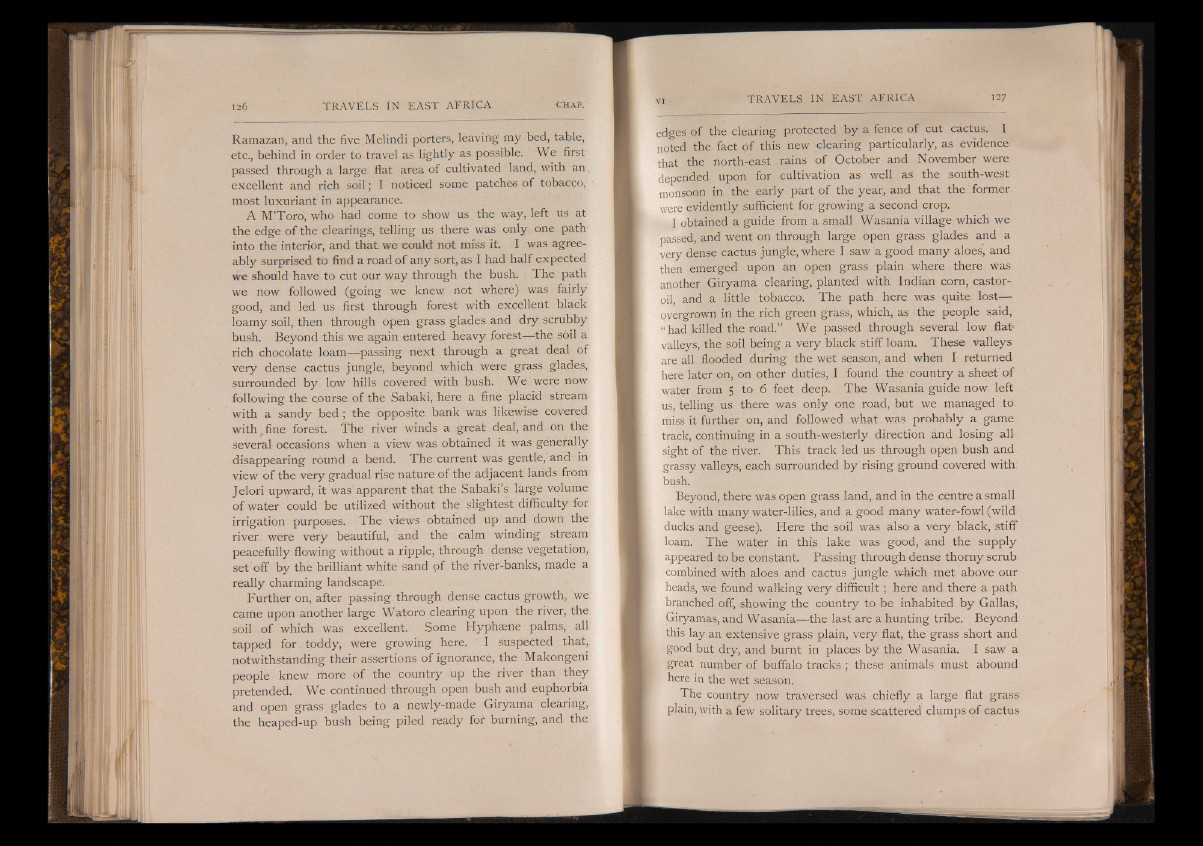
Ramazan, and the five Melindi porters, leaving my bed, table,
etc., behind in order to travel as lightly as possible. We first
passed through a large flat area of cultivated land, with an,
excellent and rich soil; I noticed some patches of tobacco,
most luxuriant in appearance.
A M’Toro, who had come to show us the way, left us at
the edge of the clearings, telling us there was only one path
into the interior, and that we could not miss it. I was agreeably
surprised to find a road of any sort, as I had half expected
we should have to cut our way through the bush. The path
we now followed (going we knew not where) was fairly
good, and led us first through forest with excellent black
loamy soil, then through open grass glades and dry scrubby
bush. Beyond this we again entered heavy forest— the soil a
rich chocolate loam— passing next through a great deal of
very dense cactus jungle, beyond which were grass glades,
surrounded by low hills covered with bush. We were now
following the course of the Sabaki, here a fine placid stream
with a sandy bed; the opposite bank was likewise covered
with, fine forest. The river winds a great deal, and on the
several occasions when a view was obtained it was generally
disappearing round a bend. The current was gentle, and in
view of the very gradual rise nature of the adjacent lands from
Jelori upward, it was apparent that the Sabaki’s large volume
of water could be utilized without the slightest difficulty for.
irrigation purposes. The views obtained up and down the
river were very beautiful, and the calm winding stream
peacefully flowing without a ripple, through dense vegetation,
set off by the brilliant white sand of the river-banks, made a
really charming landscape.
Further on, after passing through dense cactus growth, we
came upon another large Watoro clearing upon the river, the
soil of which was excellent. Some Hyphsene palms, all
tapped for toddy, were growing here. I suspected that,
notwithstanding their assertions of ignorance, the Makongeni
people knew more of the country up the river than they
pretended. We continued through open bush and euphorbia
and open grass glades to a newly-made Giryama clearing,
the heaped-up bush being piled ready fof burning, and the
edges of the clearing protected by a fence of cut cactus. I
noted the fact o f this new clearing particularly, as evidence
that the north-east rains o f October and November were
depended upon for cultivation as well as the south-west
monsoon in the early part of the year, and that the former
were evidently sufficient for growing a second crop.
I obtained a guide from a small Wasania village which we
passed, and went on through large open grass glades and a
very dense cactus jungle, where I saw a good many aloes, and
then emerged upon an open grass plain where there was
another Giryama clearing, planted with Indian corn, castor-
oil, and a little tobacco. The path here was quite lost—
overgrown in the rich green grass, which, as the people said,
“ had killed the road.” We passed through several low flak
valleys, the soil being a Very black stiff loam. These vaileys
are all flooded during the wet season,, and when I returned
here later on, on other duties, I found the country a sheet of
water from 5 to 6 feet deep. The Wasania guide now left
us, telling us there was only one road, but we managed to.
miss it further on, and followed what was probably a game
track, continuing in a south-westerly direction and losing all
sight of the river. This track led us through open bush and
grassy valleys, each surrounded by rising ground covered with:
bush.
Beyond, there was open grass land, and in the centre a small
lake with many water-lilies, and a good many water-fowl (wild
ducks and geese). Here the soil was also a very black, stiff
loam. The water in this lake was good, and the supply
appeared to be constant. Passing through dense thorny scrub
combined with aloes and cactus jungle which met above our
heads, we found walking very difficult; here and there a path
branched off, showing the country to be inhabited by Gallas;
Giryamas, and Wasania— the last are a hunting tribe. Beyond
this lay an extensive grass plain, very flat, the grass short and
good but dry, and burnt in places by the Wasania. I saw a
great number of buffalo tracks ; these animals must abound
here in the wet season.
The country now traversed was chiefly a large flat grass
plain, with a few solitary trees, some scattered clumps of cactus